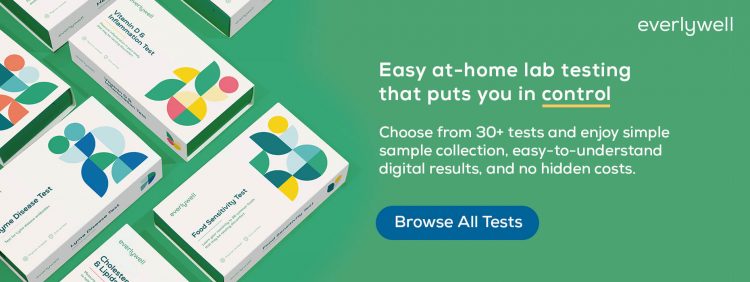Medically reviewed on March 8, 2022 by Jordan Stachel, M.S., RDN, CPT. To give you technically accurate, evidence-based information, content published on the Everlywell blog is reviewed by credentialed professionals with expertise in medical and bioscience fields.
Ovarian cysts are a highly common abnormality, affecting approximately 20% of people assigned female at birth [1]. These cysts can occur in the ovaries when a sac containing the oocyte (or egg) fills with fluid, forming a cyst.
Fortunately, most ovarian cysts are painless, benign, and result in no complications for the individuals who get them. In fact, many ovarian cysts are discovered only by happenstance during routine physical exams or imaging procedures.
While most ovarian cyst cases are innocuous, there are some circumstances in which they can pose a danger to health and the ability to conceive. Below, we’ve reviewed the types of ovarian cysts, how they may affect fertility, and what can be done if they develop (to learn more about your ovarian health, consider the Everlywell at-home Ovarian Reserve Test or Women’s Fertility Test).
What are ovarian cysts?
There are three types of “functional” ovarian cysts. Functional cysts are benign and non-disruptive. These include:
- Follicular cysts – A follicular cyst can occur when a premature egg isn’t released from an ovarian follicle. Typically, this type of cyst arises because levels of follicle-stimulating hormone (FSH) or luteinizing hormone (LH) are out of balance, ultimately obstructing and leading to irregular ovulation.
- Corpus luteal cysts – Corpus luteal cysts occur when the corpus luteum, or empty egg sac, fills with fluid following ovulation. In normal reproductive cycles, if a released egg goes unfertilized, the corpus luteum sheds within 2 weeks of ovulating. However, if the corpus luteum is not fully shed from the ovary, it can result in a corpus luteal cyst.
- Theca lutein cysts – Theca lutein cysts are a common side effect for individuals undergoing hormonal therapy during fertility treatment. These types of cysts arise when hormones are used to artificially stimulate ovulation, causing an excessive number of cells to grow in the ovaries [2].
For most individuals in their reproductive years, ovarian cysts are naturally resolved by the body and result in no pain, discomfort, or complications.
However, it is possible for ovarian cysts to result in serious complications that call for treatment or even surgical intervention. On rare occasions, ovarian cysts can result in [1]:
- Severe pelvic pain
- Hemorrhage or rupture
- Torsion of the ovaries
- Infertility
The most important risk factor for ovarian cyst complications is age. Individuals past their reproductive years are at a higher risk of developing malignant cysts that can lead to severe consequences, such as ovarian cancer. So if you have ovarian cysts and are going through (or have already been through) menopause, be sure to discuss more rigorous screening options with a healthcare provider.
How ovarian cysts can affect fertility
While most ovarian cysts heal without intervention, those that don’t resolve on their own may impact the ability to conceive.
How exactly can ovarian cyst cause infertility? There are two ways:
- Structurally – This is when ovarian cysts inhibit the organs involved in conception and pregnancy (as in the case of endometriosis).
- Hormonally – This is when cysts interrupt the hormonal relay between the brain and the ovaries. This relay is important because it tells the ovaries when it’s time to grow the eggs and release them. When abnormal or overgrown ovarian cysts occur, they can interrupt the steady back-and-forth between the brain and reproductive organs, resulting in difficulty with conceiving.
What kinds of ovarian cysts affect fertility?
Although ovarian cysts can occur on their own, they can also exist as a concurrent symptom alongside other reproductive conditions that may affect fertility and overall health.
Among the most common of these conditions are endometriosis and polycystic ovary syndrome. Let’s explore each of these below.
Endometriosis
Endometriosis is a condition that affects between 2 and 10% of American people assigned female at birth in their primary reproductive years. It occurs when endometrial tissue (the tissue that lines the inside of the uterus) grows outside of the uterus. The cysts that arise in individuals with endometriosis are known as endometriomas, though they’re colloquially referred to as “chocolate cysts” because of their dark color.
There are two types of endometriomas:
- Type 1 – A less severe growth of cysts typically found along the membrane surrounding the pelvic organs.
- Type 2 – A more severe variation that results when the endometrial tissue attacks already existing functional cysts [1].
Often, endometriosis is an extremely painful condition. Common symptoms of endometriosis include:
- Pain or discomfort during sexual intercourse
- Heavy, painful periods, with cramping radiating to the stomach or lower back
- Severe pain or discomfort when using the bathroom during a menstrual cycle
- Digestive discomfort or pain during bowel movements
- Difficulty conceiving
Despite the severity of some cases of endometriosis, the condition is treatable. People with endometriosis may even take a more aggressive approach to ovarian cyst screening and treatment, with [3]:
- Regular check-ups to detect endometriosis via sonogram
- Hormonal therapy
- Surgical removal of the growths (if necessary)
Polycystic ovary syndrome
Polycystic ovary syndrome, or PCOS, is a medical condition that affects between 5 and 10% of people with uteruses in their reproductive prime [1]. In fact, PCOS is one of the primary causes of female infertility.
Classified as a hormonal disorder, PCOS occurs when the ovaries overproduce androgens, a type of male hormone, which disrupts the ovaries’ ability to grow eggs to maturity and ovulate. In patients, this usually results in at least two of the following outcomes:
- Ovarian cysts on one or more ovaries
- Elevated androgen levels
- Lack of ovulation, resulting in erratic or completely absent menstrual cycles
While not all people with PCOS develop cysts in their ovaries, all individuals with this condition experience a hormonal imbalance that interferes with the healthy regulation of their reproductive cycles. Some common, noticeable symptoms of this condition include [4]:
- Light and short, irregular, or absent menstrual cycles
- Swollen ovaries
- Excessively oily skin
- Body hair growth around the torso, chest, and back
- Abdominal weight gain
The cause of PCOS remains unknown, though a substantial body of evidence suggests high correlations with other conditions. For instance, obesity and insulin resistance, most commonly found in individuals with type II diabetes, are both major risk factors for developing PCOS. Genetics also plays a role, as people who have relatives with PCOS are more susceptible to developing the disorder.
If you’re diagnosed with PCOS, there is at a heightened risk of developing the following comorbidities:
- Sleep disturbances (such as obstructive sleep apnea)
- Metabolic disturbances
- Cardiovascular disease
- Mental health disruptions or mood disorders
- Endometrial cancer
- Infertility
Unfortunately, many people do not discover they have PCOS until they encounter difficulty when trying to conceive [5].
While there’s currently no cure for PCOS, you can treat the associated symptoms through lifestyle modifications and medication. It’s also important to note that people with PCOS may still conceive.
Ovarian cysts: risk factors and treatment options
Apart from age, several other circumstances may increase the likelihood of developing ovarian cysts:
- Fertility treatment – Ovarian hyperstimulation syndrome affects many people seeking fertility treatment, resulting in the excessive responsiveness of ovaries to hormonal therapy. At times, treatment meant to stimulate egg development may result in ovarian cysts.
- Pregnancy – It’s not uncommon for pregnant people to develop ovarian cysts in their second trimester. This is the result of an elevation in the human chorionic gonadotropin (hCG) hormone.
- Environmental toxins – Like many reproductive abnormalities, there is a high correlation between environmental toxins and the development of ovarian cysts. Studies have shown that cigarette smoking is highly related to the development of ovarian cysts, with non-smokers having a lower lifetime risk of cyst development compared with former tobacco users, as well as active smokers [6].
The treatment of ovarian cysts depends on the following key factors:
- Age and menopausal status
- Size, quantity, and quality of the cysts
- Whether the cysts cause pain or discomfort, which may indicate a rupture
Depending on the individual, ruptured ovarian cysts may cause mild symptoms or severe pain and bleeding. Severe ruptures may require surgery, but in most cases, ovarian cysts are managed by pain medication and close monitoring to rule out any further complications [7].
Stay on top of reproductive health with Everlywell
Interested in learning more about your fertility and reproductive health? Consider the Everlywell at-home Ovarian Reserve Test to gain information relevant to egg quantity or the Women’s Fertility Test to check in on the hormones that influence normal ovarian function.
Related content
What ovarian reserve testing can tell you about fertility
How many eggs does a woman have?
Freezing your eggs: is it right for you?
References
1. Ovarian Cyst. StatPearls [Internet]. URL. Accessed March 8, 2022.
2. Ovarian cysts: Overview. InformedHealth.org [Internet]. URL. Accessed March 8, 2022.
3. Hsu AL, Khachikyan I, Stratton P. Invasive and noninvasive methods for the diagnosis of endometriosis. Clin Obstet Gynecol. 2010;53(2):413-419.
4. What are the symptoms of PCOS? National Institutes of Health. URL. Accessed March 8, 2022.
5. Polycystic Ovary Syndrome (PCOS). National Institutes of Health. URL. Accessed March 8, 2022.
6. Wyshak G, Frisch RE, Albright TE, Albright NL, Schiff I. Smoking and cysts of the ovary. Int J Fertil. 1988 Nov-Dec;33(6):398-404. PMID: 2906914.
7. Lim WH, Woods N, Lamaro VP. Trends and outcomes of ruptured ovarian cysts. Postgrad Med J. 2021 Mar 12:postgradmedj-2020-138833. Epub ahead of print. PMID: 33712434.
Source by www.everlywell.com


